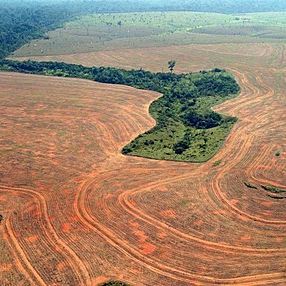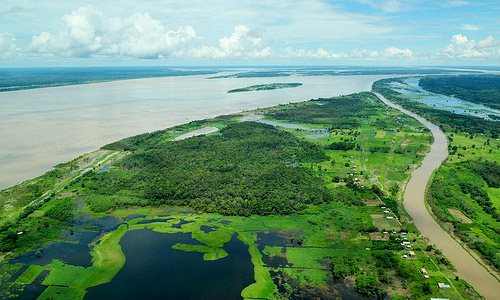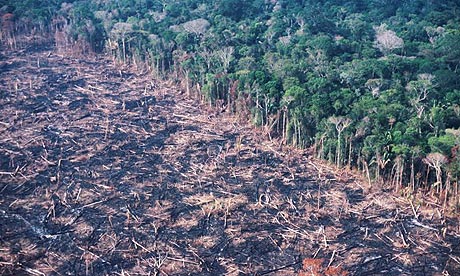As Roads Spread in Rainforests,
The Environmental Toll Grows
From Brazil to Borneo, new roads are being built into tropical forests at a dizzying pace, putting previously intact wilderness at risk. If we hope to preserve rainforests, a leading researcher says, new strategies must be adopted to limit the number of roads and reduce their impacts.
http://e360.yale.edu/feature/as_roads_spread_in_tropical_rain_forests_environmental_toll_grows/2485/
 |
| The Amazon: via here. |
Today I was sent the link to the Prince's Rainforests Project's November 2012 report on 'Interim REDD+ Finance: Current Status and Ways Forward for 2013 - 2020'.
Quite accessible reading this is an outline of the initiative:
1.3. About this paper
1.3.1. The Prince’s Rainforests Project and tropical rainforests
The Prince’s Rainforests Project (PRP) is part of The Prince’s Charities’ International Sustainability Unit (ISU), a charitable organisation that works to build consensus around durable solutions to meeting the challenges of climate change, sustainable development and natural resource depletion.
The Emergency Package reviewed potential innovative financial mechanisms that would provide funds for rainforest nations to use to pay for the transition to a low carbon alternative development path. It was anticipated that the funding would need to be long-term in nature and linked to reduced rates of deforestation.
Below are core principles:
1.3.1. The Prince’s Rainforests Project and tropical rainforests
The Prince’s Rainforests Project (PRP) is part of The Prince’s Charities’ International Sustainability Unit (ISU), a charitable organisation that works to build consensus around durable solutions to meeting the challenges of climate change, sustainable development and natural resource depletion.
The PRP was established in 2007 by His Royal Highness The Prince of Wales to encourage consensus on how the rate of tropical deforestation might be slowed.
Following extensive consultation, the PRP published a report in March 2009 entitled ‘An Emergency Package for Tropical Forests’12 (see Box 1). At the core of the report’s proposal stood the idea that, in the absence of an international climate agreement, there was a need for significant interim REDD+ finance to be catalysed at scale in order to support rainforest countries wishing to redirect their development paths away from deforestation. Such funding would, it was argued, act as a ‘bridging mechanism’ to a future international agreement defining how REDD+ would operate and be financed at scale and in the long-term.The Emergency Package reviewed potential innovative financial mechanisms that would provide funds for rainforest nations to use to pay for the transition to a low carbon alternative development path. It was anticipated that the funding would need to be long-term in nature and linked to reduced rates of deforestation.
Below are core principles:
Box 1: Ten core principles and ideas set out in the PRP’s ‘Emergency Package’:
- payments to rainforest nations for not deforesting;
- multi-year ‘service agreements’ based on clear performance targets;
- payments used to fund alternative, low carbon economic development plans;
- transparent, multi-stakeholder disbursement mechanisms in-country;
- a ‘Tropical Forests Facility’ focused on results;
- developed country financing from public and private sources;
- ‘Rainforest Bonds’ issued in private capital markets;
- rainforest nations participate when ready;
- facilitating and accelerating a long-term UNFCCC agreement on forests, and
- global action to address the drivers of deforestation.
I'm including a little more from this 31 page paper because it is the kind of material most of us never see ... yet it is written in accessible language and does provide complex material as comprehendible concepts.
Summarized below are five case studies that illustrate different pathways to avoiding deforestation, suggesting there is no ‘one size fits all’ solution for REDD+, but rather that a combination of these approaches can together have the most powerful effect.
Success in Brazil: Political will, national leadership, enforcement and an active civil society
Brazil has been the most successful country at lowering deforestation rates over the past decade, reducing emissions from land use change by over two-thirds, resulting in a larger overall climate mitigation impact than any single developed country has achieved. This effort has required a range of complementary actions by government, business and civil society, suggesting there has been no ‘silver bullet’ that explains Brazil’s success, but rather that it has come about through a range of policies, enforcement, improved technology and public pressure. Furthermore, the success has not come at the expense of economic development in agricultural sectors, the main drivers of deforestation. Some of the key contributing factors for Brazil’s success include:
-
High-level political commitment at national and state levels. In 2010, President Lula pledged to reduce
Brazil’s emissions by 80% by 2020 (compared with its average rate over the decade 1996 – 2005), most of
which would be achieved through reduced deforestation25. In addition, at the state-level, many Governors
have also committed to forest conservation and been instrumental in reducing Brazil’s national deforestation
rates26. Most recently, for example, Governor Simao Jatene announced a target of zero deforestation by
2020 for the state of Para.27

Amazon Rainforests
-
Policy actions at the federal level: land tenure, enforcement, and monitoring. Brazil has, over the past
decade, considerably expanded indigenous reserves and protected areas. Indigenous peoples’ land tenure
rights have been reinforced and they now control 20% of the Brazilian Amazon. Brazil has also increased
and improved law enforcement, cracking down against illegal loggers and corrupt government officials28.
Finally, specific federal-level policies such as changes to agricultural subsidies, provision of credit, and the
imposition of deforestation moratoria, have also contributed to success29.
-
Transparent monitoring and civil society pressure. Extensive monitoring and increased transparency
by the Brazilian space research agency (INPE) has also been key to success. In 2003, INPE made their
data freely available online. Investigative reports by NGOs, and a highly successful ‘Zero Deforestation’
campaign, generated much attention on the businesses that were causing deforestation, most notably in the
soy and beef sectors.
-
Business involvement. In response to the pressure generated by civil society, businesses have worked
together to establish appropriate forest conservation practices. A prominent example is the voluntary
moratorium on growing soy in newly deforested areas. While reducing deforestation, businesses were also
able to capitalize on technology improvements to increase their yields, and expand onto previously cleared
and degraded land, providing the opportunity for soy and beef production to be increasingly decoupled from
deforestation.
As with all of these approaches, and every country, Brazil’s remarkable successes and leadership with respect to the reduction of deforestation cannot be wholly assured over time. There will be ongoing challenges with respect to the adequate implementation of the Brazilian Forest Code, so as to ensure that its measures do not lead to an increase in deforestation. The same applies to the Amazon Fund which, though it is yet to disburse much money, may still prove critical in terms of providing future incentives as political pressure mounts and commodity prices rise.
The Guyana-Norway Partnership: REDD+ and low carbon development
Guyana’s story is evolving and has taken quite a different pathway from Brazil. Guyana began not only with a high-level commitment to reducing deforestation, but with a partnership between a tropical forest country and a committed donor country. As a country with historically low levels of emissions from deforestation, Guyana also presents an interesting case study that illustrates how REDD+ financing can promote overall economic development while averting leakage from neighbouring countries and global pressures as demand for commodities grow30. The key features of the case include the following:
-
Political, high-level commitment to low carbon development. In 2007 the then President of Guyana,
Bharrat Jagdeo, presented a challenge to his country – to create a low carbon development strategy in
which standing forests would be valued and turned into investments that benefited the country’s sustainable
development.
-
Norwegian commitment. The Norwegian Government then made a US$250 million pledge to pay $5/
ton for verified emission reductions from deforestation. The Guyana REDD+ Investment Fund (GRIF) was
established for this purpose. The predictability of financial resources has been a unique catalyst for change
and allows Guyana to place a monetary value on the global benefits that their standing forests provide.
15
-
Reinvesting in a low carbon economy. The GRIF incorporates REDD+ into the country’s Low Carbon
Development Strategy (LCDS) by allowing monies from verified emission reductions in the forest sector
to be reinvested in other elements of the strategy. It has the ultimate aim of developing six low carbon
economic sectors and improving adaptation and development for indigenous people, forest-dependent
communities, and vulnerable groups31. The majority of funds are invested in the LCDS with some money
also going towards ongoing support for capacity-building directly related to REDD+ and the LCDS.
-
Creating a “green market economy”. Guyana’s LCDS capitalizes and leverages private sector finance
and aims to ‘mimic’ and stimulate the market as it creates a green economy in Guyana that includes value for
forest climate services. One example of this is the plan to use some of the proceeds from forest protection
to catalyse large-scale private investments into a new hydropower facility that is anticipated to reduce
consumers’ energy bills, as well as reduce national energy emissions, by 92% by 2017.32
As with Brazil, the success of the Guyana-Norway partnership is not guaranteed, despite a commitment from Guyana’s current President to seeing through the work initiated by his predecessor. It is contingent on the resolution of outstanding land tenure challenges; ongoing consultation with indigenous and forest communities; support from the Guyanese electorate; and efforts to mitigate the increases in mining and infrastructure development in parts of the country.

SubnationalApproaches: BuildingblockstofuturenationalREDD+systems
While the first two case studies, Brazil and Guyana, are national level programmes, it is also worth noting the progress and effort being made at subnational levels. A number of countries recognise that creating operational REDD+ systems at the national level can be quite complex and difficult, particularly where land and resource management has been devolved to local levels or where regional differences within a country make a one-size-fits- all national programme ineffective. In these cases, such countries have chosen to begin planning and implementing REDD+ at a subnational level, while continuing to build capacity and monitoring systems at a national level. It is recognized that even if a country decides to pilot REDD+ at subnational levels, national level coordination of both financial instruments and methodological choices is also critical to scaling up over time.
Nigeria: Piloting REDD+ in Cross River State. Nigeria’s REDD+ Readiness programme envisions a two-track approach: (a) developing institutional and technical capacities at the federal level and (b) carrying out intense institutional, strategy-building and demonstration activities in Cross River State.33 Cross River State, which has more than 50% of Nigeria’s remaining tropical high forests, declared a moratorium on timber extraction in 2008 but is also exploring new environmental finance mechanisms to further protect its forests, with a priority on enhancing the livelihoods of forest-dependent communities and rural dwellers34. Nigeria expects the focus on Cross River to help inform the national REDD+ framework and provide a model for replication in other interested states.
Vietnam: Initiating REDD+ in Lam Dong, Dien Bien, Kon Tum and five other provinces. Vietnam is also taking actions to reduce its emissions, including development of a REDD+ National Action Plan that includes key legal and institutional roles. While it is pursuing this national framework, it is also pursuing demonstration activities in at least eight pilot provinces, building provincial MRV capacities, implementation strategies and benefit distribution systems—and exploring the potential of nested approaches to REDD+.35
Peru: A Nested Approach to REDD+. According to Peru’s REDD+ strategy: “... the State decentralization process points to the need for a flexible, gradual focus, working with a nested approach at all three levels: readiness, implementation, and payment for results... a nested approach will allow the country to address its implementation at different rates, in accordance with the development of technical capacities, and to add efforts at regional level until moving up to national level... pioneering regions such as Madre de Dios and San Martin...”36 San Martin, for example, has created a REDD+ Roundtable chaired by the regional government to discuss the development of a REDD+ programme, and an Advisory Committee and technical Working Group to analyse the drivers of deforestation, develop reference scenarios, assess carbon stocks, and is considering social aspects of REDD+ including effective stakeholder engagement.

Brazil
Brazil: State-level actions and success in reducing deforestation. It would be difficult to mention subnational actions without crediting Brazilian states for their efforts taken to date to reduce deforestation. In 2009, Acre approved a law creating an ambitious Environmental Service Incentive System (SISA) that provides incentives for reducing emissions from deforestation and forest degradation and is one of the most advanced jurisdiction-wide REDD+ programmes in the world. Its programme involves a new model of rural development that improves the livelihoods of forest-dependent communities, maintains and restores biodiversity, soils, and water resources, while also seeking greater productivity and market opportunities for its farm and livestock sectors.38 Meanwhile, Mato Grosso, the nation’s largest agricultural producer, has achieved the steepest decline in deforestation—85% below the 1996-2005 average—while increasing crop and livestock production.39 Emissions reductions since 2005 in the state of Mato Grosso alone are among the largest single reductions of GHG emissions globally.

Deforestation in the Amazon rainforests of Brazil. Photograph: Stephen Ferry/Getty 

image here: https://www.pacificforest.org/news_story10205.html As a young Art teacher in 1983 I moved to a small community in South Coast NSW where the forests were being cut and shipped to Japan as wood chips. Students fought frequently with each other in my class room ....depending on their family politics. In 1983 it was a hot debate in that town. A livelihood for some and devastation for others.Then I read a book about the practices of McDonalds in the Amazon and I found it hard to refrain from discussing that with students. I never imagined we would continue so obliviously all these decades later. The crisis I feared then is large and real today. -
High-level political commitment at national and state levels. In 2010, President Lula pledged to reduce
Brazil’s emissions by 80% by 2020 (compared with its average rate over the decade 1996 – 2005), most of
which would be achieved through reduced deforestation25. In addition, at the state-level, many Governors
have also committed to forest conservation and been instrumental in reducing Brazil’s national deforestation
rates26. Most recently, for example, Governor Simao Jatene announced a target of zero deforestation by
2020 for the state of Para.27

2 comments:
reminds me of we have met the enemy and they are us. so sad. we few (it seems) do what we can to love the earth (i do mean that as trite as it sounds) because i think only love will save it.
yes... i think much as you do Velma...
not trite... such a deep accessing of feeling and thought as love in order to embrace this matter!
So pleased you write a comment here.
Post a Comment